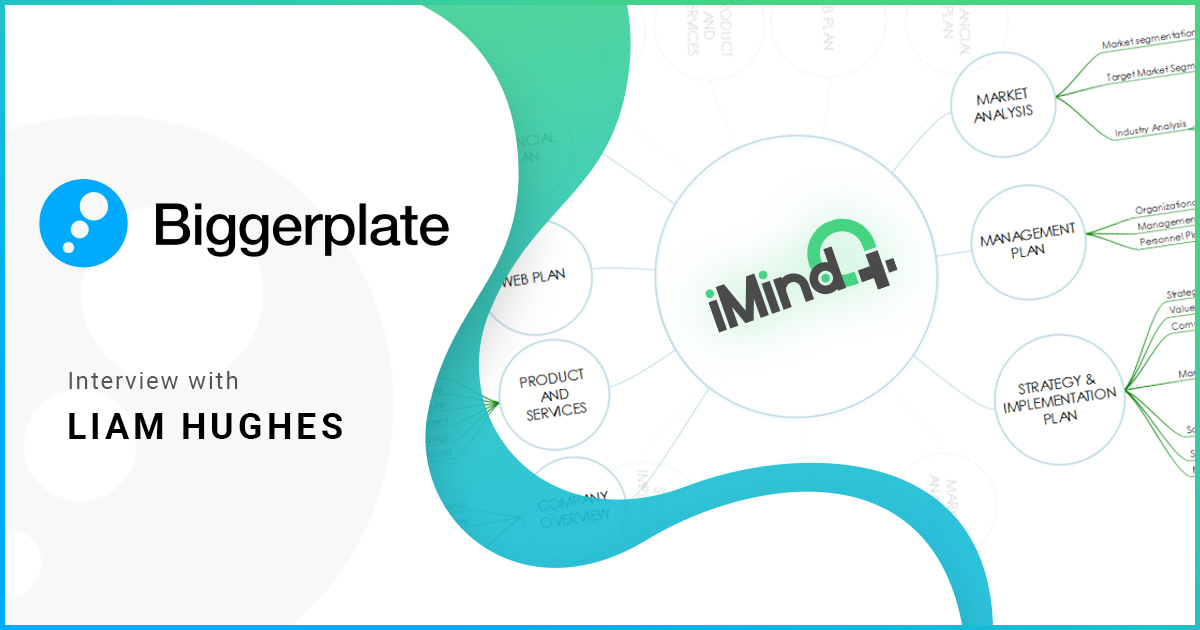Hello Liam! Your experience and knowledge in this area are highly respected, and we believe your perspective would be incredibly beneficial. Taking into consideration the years that Biggerplate is out there on the market, we would love to hear more about your perspective on emerging trends in future and the direction where mind mapping is going.
Let’s start with the questions!
1. Can you tell us a bit about your journey and how you got started with mind mapping?
LH: I was introduced to mind mapping software in 2006, when I was very close to failing my university degree! I tried mind mapping my subjects as a last hope to pass my exams, and I was amazed at the positive difference this made, and luckily, managed to pass my exams. As such, I’ve always said that mind mapping saved my degree.
It was from that experience that I had the idea to start a mind map library for students, which became Biggerplate.com. The website launched in 2008, and since then has grown into the largest community of mind mappers in the world, with over 250,000 members. The website now hosts mind maps and video resources covering business, education and everything else! Our goal is to help people go further with mind mapping in their work, studies, and at home.
2. In your experience, what are the most significant benefits of using mind maps?
LH: I know that from my own work, and from listening to feedback from our community members, the key benefit that emerges repeatedly is clarity. Whether in a personal or professional capacity, the process of getting ideas and information out of your head and into the visual structure of a mind map seems to help clarity to emerge. I often compare mind mapping to building a jigsaw puzzle, where you have to have all the pieces visible in front of you, and then you start testing different combinations of pieces until a picture starts to emerge. The same is true in mind mapping, but the puzzle pieces are ideas and bits of information. By capturing in the mind map, then categorizing and sub-categorising, we eventually start to see how things fit together, and from this, clarity emerges.
3: What are the top emerging trends that we can expect for 2025 in mind mapping?
LH: Certainly, the biggest trend that we’re seeing over the last 12 months is the emergence (or explosion) of Artificial Intelligence around the world in all fields, and mind mapping is no exception. We’re seeing established mind-mapping software vendors integrating AI functionality into their products to help users generate or refine ideas, and we’re seeing new entrants into the market who are leading with AI mind-mapping as their core offering.
I’d expect to see a continuation or evolution of this trend into 2025, and expect we’ll see the more established software players refining their in-product AI functionality, whilst (hopefully) improving the messaging and explanations of why this functionality is helpful to the end user, rather than just shouting “now with AI”…!
4. How do you see mind mapping evolving in the next few years, especially with the growth of new technologies?
LH: As mentioned above, it’s clear that AI is going to play a part in the future, and it will be interesting to see how software developers respond in this area. I think there is still a lot of work to be done around explaining the how, why and when for AI in mind mapping software. Simply telling people your product has AI is one thing but making it clear to the end user how this might help them, why they should try it, and when it’s relevant to use (vs not use) is going to be important in my opinion.
Other technologies that seem likely to influence the evolution of mind mapping are virtual and augmented reality, whereby people could immerse themselves either partially or entirely within a mind map or visual diagram and work interactively with the content using motion, touch, or voice prompts. There are fewer visible public examples of this technology so far, and of course the promise of VR has not perhaps been realised more broadly yet, largely due to the price and bulk of hardware headsets it seems. However, I expect we’ll see some hardware and software innovation in this area over the coming years that is certain to influence the world of mind mapping software.
5. What are some tips or best practices you would recommend to someone just starting with mind mapping?
LH: We always encourage people to Capture and Categorise as the first essential steps when using mind mapping software. Software like iMindQ makes it so easy to capture and move topics around, that the best thing you can do is just start capturing ideas and information in the mind map, then move the topics around, dragging and dropping them into categories and sub-categories that will naturally emerge as you start to capture more ideas. The more ideas you capture, the more clearly your categories will emerge. As your categories emerge, more ideas will come to mind… it’s a virtuous cycle!
A second key tip is to be keyword-focused as you mind map, capturing just one, two, or three words at a time, and avoiding big blocks of text or long sentences. This helps to make the information in the map more manageable, and easier to move around the canvas. If you need to capture more text and detail, then software like iMindQ makes it easy for you to capture extra detail using the ‘Notes’ feature, which can help you add lots of text and detail without cluttering up the surface level of your mind map.
6. Can you share a memorable mind mapping experience or success story that had a significant impact on you?
LH: Probably my most memorable mind mapping experiences have come when facilitating workshops and meetings for clients, using mind mapping to both design and deliver the workshop discussions. The mapping works so well to capture and refine the key discussion notes and enable people to see how and where their perspectives do or do not align. The clarity provided by the keyword focused diagram, and the adaptability of moving items around the map have enabled me to support successful dialogue and discussions around the world, often in very high stakes situations. We’ve been fortunate enough to provide mind mapping support for summits about vulnerable women and people trafficking in the EU and helped a Latin American mining company engage their employees in strategic planning, many of whom were former guerilla fighters. We’ve been part of some fascinating discussions about the creation of “smart cities”, and the ways to make cities resilient in the face of climate change. And we’ve also helped small businesses and entrepreneurs to map out their big ideas and business plans during annual planning and strategy sessions. Every time, the mind map is both the focus, and the enabler of quality thinking. What emerges every time, is clarity.



